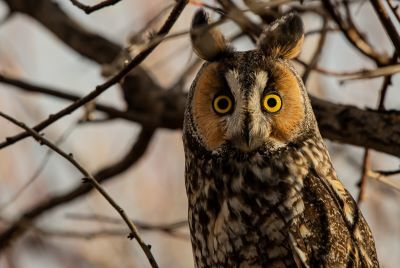
Good Natured: The Phenomenal Hearing of Owls
My goodness, have you heard the owls lately? It's courtship time for Bubo virginianus, the great horned owl, and males and females have been hooting up a storm.
It's a pretty unmistakable sound—repetitive hoots that seem to be saying, “Who's up late? Me too!" In fact, if you listen closely, you'll even be able to tell wh-who's who. The male GHO, wh-who can be up to one-third smaller in size than the female, has a deep hoot; the female's call, though just as loud and resonant, has a noticeably higher pitch.
I think we've all been lucky enough to hear an owl at least a time or two. But how many of us have actually stopped to consider how the owls hear themselves?
Phenomenal hearing and unique ear placement are two of many adaptations owls possess that help thrive in their (mostly) nocturnal lifestyle. Yet just as there are many types of owls, there also are several types of owl ears.
But before we delve into the features that make owl ears so extraordinary, we first need to take a look at part of the owl's external anatomy. I'm sure there's a medical term used to describe this area, but for our purposes we're just going to call it the head.
In some species—great horned, screech and long-eared owls come to mind--the head has two tufts projecting from the top. Many references call these prominent features “ear tufts," as their placement is very near where we've come to expect ears on animals like dogs and cats. But other references use the fancy word plumicorn(s), which is derived from the Latin pluma, or soft feather, and corn, Latin for horn.
Regardless of what they're called, these tufts are nowhere near the owl's actual ears, and play no role in the animal's hearing. They do however have a couple of important functions. When an owl is resting in a tree in the daytime, the tufts on top of the head help break up its silhouette, and help it better blend in against the bark and branches.
At other times, when an owl with tufts is awake and communicating, with either other owls or other species entirely, those plumicorns function kind of like our eyebrows, and can be used to convey owl attitudes. Pulled back indicates an angry or defensive owl; straight up means the bird is alert or excited.
The ears themselves, however, actually are farther down, on either side of the head, right about eye level. In some owl species, the position of the ears is earily (see what we did there?) like our own. That is, the ears are placed symmetrically, one on either side of the head and pretty much opposite each other. Great horned owl ears are like this, as are the ears of screech owls.
But then we have those species known for their asymmetry—one ear is higher than the other. You can't really see this lopsidedness when looking at the bird itself, but when examining specimens or skulls the difference is obvious. Saw-whet owls display a great degree of asymmetry, as do long-eared owls and barn owls. Barred owl ears are asymmetrical too, but to a lesser degree.
You'd think having ears all cattywampus would be a disadvantage, but this unevenness is a big help when hunting in deep snow, or when light conditions are low. Sounds will hit one ear before the other, and the owl's brain can then quickly sort out which direction they're coming from. (Fun fact: An owl's medulla—the part of the brain that processes hearing—has three times as many neurons as those found in a crow.)
Aligned or askew, owl ears always work in conjunction with another important feature: the facial disk. It's something every owl has, and it's much more than just a pretty feature.
The facial disk is a curved ring of stiff feathers that functions kind of like a satellite dish, gathering sounds and directing them to the ears at the sides of the face. It increases the surface area on which sound can be collected, and thanks to feathers that can be manipulated to direct the movement of the sound, it enhances the owl's sound sensitivity by an estimated 20 decibels. (Fun fact No. 2: You do the same thing, sort of, when you cup your hands behind your ears.)
To maximize their facial disk's effectiveness, owls have one other super cool adaptation: Their bills point down. Think about it… Other birds of prey have prominent bills that point forward—all the better for aerodynamics, and for feeding. But an owl's bill is positioned downward, providing even more surface area for sound collection.
Now there's one other area where owls have a hearing advantage, and it has nothing to do with their ears: Their bodies are like a giant muffler. Soft feathers and wings that cut through the air without loud flaps mean these birds produce almost no sound when they fly. That means they can hunt on the wing and listen at the same time, without being heard by the prey below. Pretty neat, huh?
The next time you're listening for owls, be sure you're quiet and respectful. Great horned, screech, barred…long-eared, short-eared, saw-whet…barn or snowy…you know they're around, and they're listening too. For wh-who? Maybe for you!
Pam Otto is the outreach ambassador for the St. Charles Park District. She can be reached at potto@stcparks.org.

